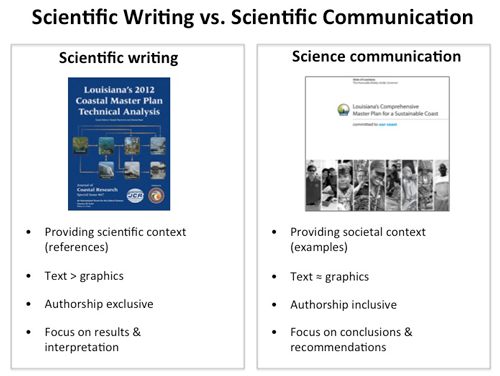Science Communication vs. Science Writing: Different audiences and different styles
Bill Dennison ·I recently received a copy of "Louisiana's 2012 Coastal Master Plan Technical Analysis, which is Special Issue #67 of the Journal of Coastal Research, co-edited by Natalie Peyronnin and Denise Reed. This 161 page issue has 10 scientific papers which describe the scientific and technical basis that underpins the Louisiana's Comprehensive Master Plan for a Sustainable Coast (2012 Master Plan) which was published in early 2012. These two documents are similar in length (Master Plan = 190 pp. vs. J. Coastal Research = 161 pp.), have the small assortment of authors and address the same topics. Superficially, it would seem redundant to produce both documents. Yet, they have two very different audiences and different styles. In addition, they are both needed to a) effectively communicate the master plan to broad audiences and b) provide the peer-reviewed scientific basis of the 2012 Master Plan.
The similarities and differences in peer reviewed scientific publications and science communication to broad audiences can be seen by comparing these two documents.

First, the similarities in the two documents will be discussed:
- Both documents use high resolution maps generated using GIS software. The use of multicolored high resolution maps require paper with a high clay (e.g., kaolinite) content which serves to make the books relatively physically heavy (2012 Master Plan = 1.5 lb; J. Coastal Research special issue = 1.3 lb).
- Both documents have ancillary supporting information that is not included in the actual document. The printed 2012 Master Plan comes with a DVD attached to the inside back cover which contains the multiple appendices which support the plan, and the online version simply provides links to the various appendices. The special issue of the Journal of Coastal Research provides extensive referencing and in some cases, URL links to more information.
- Both documents have sections or separate papers with different authors from a diversity of institutions, with authorship based on expertise and collaborations. The challenge of integrating the various separate papers and sections was accomplished through leadership from the team leaders (Natalie Peyronnin and Denise Reed). The 2012 Master Plan authorship does not parse out authorship, rather lists all of the people involved in the program at various levels. The science communicators involved in the program drafted the bulk of the text to provide a consistent style and readership level but are not even listed.
Next, the differences between the two documents will be discussed:
- The J. Coastal Research papers reference the various relevant scientific literature. A key aspect of building a scientific case is referencing the relevant previous scientific literature. Each paper references dozens of scientific papers. The 2012 Master Plan relies on the technical supporting appendices to provide the references and the plan itself does not provide references (apart from 5 citations).
- The credibility of the J. Coastal Research papers is obtained through the rigor of the peer review process, the various data and analyses that are provided in the papers, and through the various authors and institutions. The credibility of the 2012 Master Plan is through the various review panels (I co-chaired the Science and Engineering Board, for example), the transparency and public engagement process undertaken for the development of the plan, and through the use of relevant various experts both locally and from outside.
- The J. Coastal Research papers are quite dense, with condensed text, little white space and compact figures and tables. The 2012 Master Plan is much less text-oriented, with more photographs, diagrams and white space. The Master Plan text is aimed at a broad audience (high school education level), compared with the J. Coastal Research audience of college level and advanced degree holders with specialties in the relevant field of study.
It is a testament to the Coastal Protection and Restoration Authority team that both of these documents were produced within a two year period. The timeliness of the 2012 Master Plan was driven by the Louisiana legislative session schedule in early 2012. The timeliness of the J. Coastal Research special issue was quite remarkable. To be able to have ten scientific papers submitted, peer reviewed, edited and published within a year is very rapid for scientific publications. Part of the reason this special issue could be produced in a timely fashion is the amount of good teamwork that the 2012 Master Plan was able to engender. In addition, the constant scrutiny and review conducted during the 2012 Master Plan process elicited ongoing revision and synthesis so relatively high quality final products could be easily accessed for the scientific papers.
About the author
Bill Dennison

Dr. Bill Dennison is a Professor of Marine Science and Vice President for Science Application at the University of Maryland Center for Environmental Science.
Next Post > Symbols: A universal and effective technique for communication
Comments
-
Kevin Shi 12 years ago
Thanks for the article!
The contrast between the J. Coastal Research papers and the Master Plan is remarkable, and very necessary. The need for science communication and scientific writing to co-exist is becoming ever more apparent. I think too much attention has been devoted in the past towards scientific writing and this has left much of the general population "out of the loop" with regards to developments in science. Moving forward, I think more attention needs to be devoted to science communication.